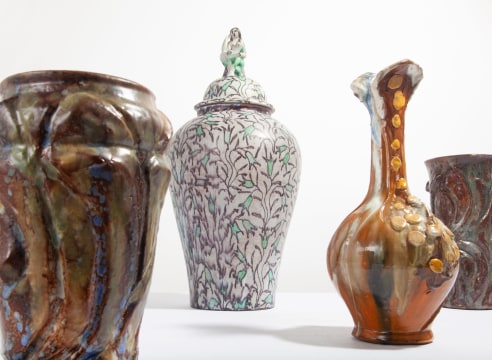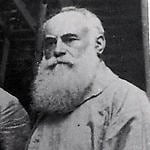

Taxile Doat (1851-1938) began working at the Sèvres National Manufactory in 1877. Throughout his tenure there, he maintained a private atelier, at first in Paris and later both in Paris and in the city of Sèvres. Doat's studio ceramics nearly rejected the classical vocabulary that dominated the remarkable pâte-sur-pâte work he created at Sèvres. His macro crystalline glazes were especially well received. Taxile Doat is best known today as the international master of grand feu (high-fired) porcelain and stoneware and one of the first successful studio potters.
In 1875, Doat moved to Paris to pursue a career in pottery. He entered the Ecole des Beaux-Arts, where he studied under the famed sculptor Augustin Alexandre Dumont. Doat must have had great natural aptitudes: only one year later he won a bronze medal for a pâte-sur-pâte plaque.
When planning a porcelain piece with pâte-sur-pâte decoration—whether vase or plaque—the form would be designed on paper, then created and fired in a muffle kiln to make it easier to work with. The surface would be coated with a colored slip, often blue to represent air or sky, and allowed to dry. Using diluted slip, generally white, the decorator would paint the figural design on the colored surface, gradually adding layers to create the appearance of a relief sculpture. For stability, the work was allowed to dry completely between applications. Before firing, the decorator would refine the relief with iron tools, smoothing out rough edges, delineating outlines, and adding incised details. At this point, it would still have been possible to use water on a paintbrush to carefully melt away an unwanted detail. When the pâte-sur-pâte work was complete, the object would be dipped in a translucent glaze and fired. Because of the action of fire on glazes, results could be unpredictable and disappointing. Doat's success was partly owing to his meticulous planning, which included the test firing of chips to be sure that he would obtain the results he sought.
Doat at Sèvres
Doat began working at the Sèvres National Manufactory in 1877 and throughout his tenure there he maintained a private atelier, at first in Paris and later both in Paris and in the city of Sèvres. He needed the freedom to experiment with materials and methods as the spirit moved him. At the Sèvres National Manufactory, he worked in pâte-sur-pâte under Marc Louis Solon, who had perfected the technique and was unusually imaginative in his choice of subjects. Solon's work was popular among critics, who praised his superb technical skills, and also among clients, who appreciated his tableaux with suggestive scenes of love among the gods, nymphs, and putti. Allusions to the sun-bleached architectural sculpture of ancient Greece and Rome lent the work a surpassing air of erudition. While employed in the decorating department at Sèvres from 1877 to 1905, Doat had specialized in the type of figural ornament known as pâte-sur-pâte that was brought to Minton and Company in Stoke on Trent, England, by Louis Marc Solon (1835-1913), who had also worked at Sèvres.
In 1895, Doat installed himself in a house at 47 rue Brancas in the village of Sèvres—almost on the doorstep of the National Manufactory—where he built a wood-burning kiln in order to fire works of his own design. Some scholars speculate that his reason for choosing this location was that he would be able to use the name Sèvres along with his personal mark on his creations.
Although Doat's production at Sèvres was prodigious, his relationship with his employer was uneasy. His audacity in creating a full-blown private atelier virtually under the nose of Sèvres, caused administrator Émile Baumgart to forbid Sèvres employees to work independently as of 1897. Doat was unrepentant and carried on as before. At the Exhibition Universelle in Paris in 1900, Doat's work for Sèvres was shown at the factory's stand, while Doat showed his studio work in his own stall. Critics found it superior to the factory work, again angering the officials at Sèvres; Doat's continued refusal to comply with Baumgart's order led to his dismissal in 1905. By then he was known internationally as one of France's finest studio ceramists. Three years later Henri Fantz spread Doat's fame, praising his independent work in The Studio (London, Aug. 1908, vol. 44. No. 185, p. 212). "Taxile Doat (formerly of Sèvres) is now producing more freely on his own account and it may be said that his vitrine was among the most interesting at the [Paris Salon of 1908], with its hard porcelain, ornamented with affixed pates, thrown up by colored glazes, dull, frosted, irisated [sic], or crystallized. And then there are his beautiful white enamels, so milky, so pure, that they conjure up visions of the loveliest creations of the Far East."
Doat at University City
In June 1909 Doat was invited to University City, Missouri. Upon Arrival he met Edward Lewis, and viewed the Art Academy building in progress. He was hired on as the director of the ceramics school and returned to France to engage assistants. When he returned to University City, he brought Emile Diffloth, a ceramic chemist, and Eugene Labarrière, a production potter. Doat's colleagues at University City also included the distinguished ceramists Adelaide Alsop Robineau and Frederick Hurten Rhead. While in America, Doat continued to create marvelous crystalline glazes on simple vase and bottle forms and also naturalistic gourd and vegetable forms.
During this second phase of activity at University City, Doat returned to making small vases using shapes and glazes that he had first produced in his private studio during the 1890s. These delicate porcelains reflected his connoisseurship of Asian porcelain, bronzes, and enamels; he was particularly interested in shapes derived from fruits and gourds. Doat developed a palette of colorful crystalline glazes, both glossy and matte in texture. During his final years at University City, he led his students in the production of hundreds of novel pieces for the Panama Pacific International Exposition to be held in San Francisco in 1915.
Doat Returns to France
In 1915, Doat returned to his atelier at 47 rue Brancas in and resumed his studio work. He again exhibited at the Salon des Beaux-Arts in Paris. In 1931 the Salon awarded him a plaquette d'honneur. There is convincing evidence —in the form of work with his mark—that Doat continued to work at a masterly level until shortly before his death at the age of 87, in 1939. Taxile Doat made a lasting contribution to field of studio pottery by example and through his widely consulted book. Without him, the ceramics revolution of the fin de siècle might not have succeeded. Doat's independent spirit, mastery of studio skills, erudition, and awareness of international art trends continue to influence serious ceramists throughout the world.
SELECTED MUSEUM COLLECTIONS
St. Louis Museum of Art,
The Metropolitan Museum of Art, New York
The Cleveland Museum of Art
The Nelson-Atkins Museum of Art, Kansas City, Missouri
The Boston Museum of Fine Arts
The Wadsworth Atenaeum, Hartford, Connecticut
The Victoria and Albert Museum, London
The British Museum, London
Musée des Arts Décoratifs, Paris
The Royal Ontario Museum, Canada